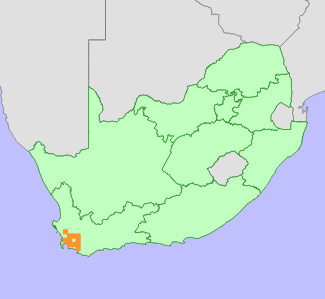|
Scientific Name | Ruschia schollii (Salm-Dyck) Schwantes |
Higher Classification | Dicotyledons |
Family | AIZOACEAE |
Synonyms | Mesembryanthemum aduncum Jacq. (later homonym), not of Haw. (1803), nor Willd, (1809), Mesembryanthemum recurvum Haw. (later homonym), not of Moench (1802), Mesembryanthemum schollii Salm-Dyck, Mesembryanthemum schollii Salm-Dyck var. caledonicum L.Bolus, Ruschia schollii (Salm-Dyck) Schwantes var. caledonica (L.Bolus) Schwantes |
National Status |
Status and Criteria | Endangered B1ab(i,ii,iii,iv,v) |
Assessment Date | 2016/01/14 |
Assessor(s) | N.A. Helme & L. von Staden |
Justification | EOO 4794 km², about 10 small, severely fragmented remaining subpopulations continue to decline due to ongoing habitat loss and degradation. |
Distribution |
Endemism | South African endemic |
Provincial distribution | Western Cape |
Range | Malmesbury to Caledon. |
Habitat and Ecology |
Major system | Terrestrial |
Major habitats | Swartland Shale Renosterveld, Breede Shale Renosterveld, Western Ruens Shale Renosterveld, Swartland Granite Renosterveld, Greyton Shale Fynbos, Elgin Shale Fynbos, Boland Granite Fynbos, Elim Ferricrete Fynbos |
Description | Lowland shale and granite-derived soils. |
Threats |
| This species has lost more than 80% of its habitat to crop cultivation. It has also declined due to habitat loss to urban expansion around Durbanville, Kuilsrivier, Stellenbosch and Somerset West, and loss is ongoing. Small remaining renosterveld fragments on agricultural land are often overstocked with livestock, and most remaining subpopulations are threatened by ongoing habitat degradation due to overgrazing. A number of subpopulations are also threatened by competition from dense, unmanaged alien invasive plants. |
Population |
This species' population has been fragmented by extensive habitat loss. About 10 subpopulations remain, and most of these occur on small, isolated fragments, and at least three on sites so degraded, they are unlikely to survive in the long term. Most subpopulations are very small, consisting of about 50 to 100 plants (N.A. Helme pers. comm.).
|
Population trend | Decreasing |
Assessment History |
Taxon assessed |
Status and Criteria |
Citation/Red List version | | Ruschia schollii (Salm-Dyck) Schwantes | EN B1ab(i,ii,iii,iv,v) | 2017.1 | | Ruschia schollii (Salm-Dyck) Schwantes | Least Concern | Raimondo et al. (2009) | |
Bibliography |
Goldblatt, P. and Manning, J.C. 2000. Cape Plants: A conspectus of the Cape Flora of South Africa. Strelitzia 9. National Botanical Institute, Cape Town.
Manning, J.C. and Goldblatt, P. 2012. Plants of the Greater Cape Floristic Region 1: The Core Cape Flora. Strelitzia 29. South African National Biodiversity Institute, Pretoria.
Raimondo, D., von Staden, L., Foden, W., Victor, J.E., Helme, N.A., Turner, R.C., Kamundi, D.A. and Manyama, P.A. 2009. Red List of South African Plants. Strelitzia 25. South African National Biodiversity Institute, Pretoria.
|
Citation |
| Helme, N.A. & von Staden, L. 2016. Ruschia schollii (Salm-Dyck) Schwantes. National Assessment: Red List of South African Plants version . Accessed on 2025/08/20 |
 Comment on this assessment
Comment on this assessment


